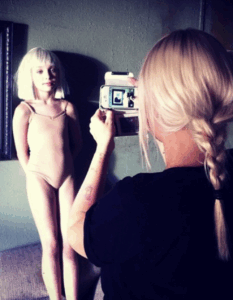
Maddie Ziegler is an American dancer, actress, and model who first rose to fame as the breakout star of the reality series Dance Moms. Recognized for her extraordinary talent at a young age, she quickly transcended reality TV and became a cultural figure when pop artist Sia cast her as the “muse” in a series of highly stylized and often controversial music videos. Although Ziegler has often spoken critically about her experience on Dance Moms and the harsh methods of her former coach, the exploitation of her talent as a child did not end there. At just 11 years old, she was cast in Sia’s breakout music video “Chandelier,” where she was costumed in a flesh-colored bodysuit and a pale, almost white wig. The effect was jarring, presenting the image of a young girl appearing nearly naked as she moved through the haunting setting of a crumbling apartment.
On Emily Ratajkowski’s podcast, Ziegler revealed that her mother, Melissa Gisoni, once apologized after witnessing the long-term effects of Dance Moms. Following a severe panic attack tied to the trauma she carried from the show, her mother told her, “I’m so sorry that I put you through that,” a moment Ziegler recalls vividly. Much of that trauma stemmed from her relationship with coach Abby Lee Miller, a dynamic that often crossed the line from demanding to obsessive and emotionally damaging.
However, Gisoni’s failure to shield her daughter from the pressures and trauma of reality television carried a painful irony, as she later permitted yet another adult woman, Sia, to place Ziegler in circumstances that many have criticized as equally, if not more, exploitative.
Sia’s use of Maddie Ziegler did not end with “Chandelier.” It continued into another music video that many critics argue was even more troubling. In “Elastic Heart,” Ziegler once again appeared in the platinum wig and flesh-toned leotard, this time smeared with dirt and moving in a manner meant to resemble a feral, animal-like state. She was paired inside a cage with actor Shia LaBeouf, then 28 years old, who wore only nude-colored briefs. The two wrestled and embraced inside the cage, with Ziegler at one point biting LaBeouf in a performance that blurred the line between raw artistic expression and the unsettling image of a grown man entangled with a young girl.
When controversy erupted around “Elastic Heart,” Gisoni dismissed the criticism outright. “I could care less,” she said during a Dance Moms season five interview, responding to those who felt the video was inappropriate. She went on to downplay the criticism by adding, “Shia LaBeouf himself texted Maddie. I think that’s a little more important than a 10-year-old’s comments,” implying that the negative reactions were nothing more than childish chatter.
While Sia bears the greatest responsibility for placing Maddie in overtly sexualized and exploitative roles, Gisoni cannot be exempt from accountability. Rather than shielding her daughter from situations that blurred the line between art and inappropriate exposure, Gisoni enabled and defended the choices that thrust Maddie into the public eye in ways no child should have been forced to endure. The silence and dismissal of criticism by guardians often underscores a troubling reality for many child stars: the very figures who are supposed to protect them instead allow their children to be used as vehicles for the ambitions or artistic visions of adults, often in exchange for money and fame.
However, Ziegler is far from the first child star to be placed in sexually exploitative circumstances. Decades earlier, Brooke Shields was around the same age when she was cast in Louis Malle’s 1978 film Pretty Baby, where she portrayed a child prostitute and was even required to kiss a much older man on screen. Beyond the film, her career included highly controversial photoshoots, including one for Playboy magazine when she was still a child.
In an interview with Bill Boggs, Brooke’s mother, Teri Shields, openly admitted to enrolling her daughter in modeling from infancy simply because she thought Brooke was beautiful. “Fortunately, Brooke was at an age, naturally, she couldn’t talk back or say she didn’t want to do it,” Teri recalled.
In the same interview, Teri remarked that Brooke was “very easy,” referring to how, even as she grew older, she rarely resisted or pushed back against the demands placed on her. Her words expose the imbalance of power that defined Brooke’s early years in the spotlight, where adults made decisions for their own gain, not for her protection. This pattern, in which children are celebrated for their compliance while the adults around them make choices in pursuit of their own goals, resurfaces decades later in Ziegler’s story.
Despite the exploitative nature of their collaborations, Ziegler has spoken fondly of Sia, even calling her a “guardian angel” during her conversation on Emily Ratajkowski’s podcast. Sia, in turn, helped Ziegler transition out of the toxic environment of Dance Moms, offering her a new platform in music videos and live performances.
Ziegler recalls that after their appearance on The Ellen DeGeneres Show to promote “Chandelier,” Sia asked, “Will you be in my next two videos and be my muse and do everything with me?” Maddie, only eleven at the time, eagerly agreed: “I was like yes,” she remembered, noting that her mother was equally excited about the opportunity.
What makes Ziegler’s recollection so striking is the innocence behind it. When Sia asked her to become her muse, Maddie didn’t pause to weigh the implications or question what the role might demand. She simply said “yes,” because at just eleven years old, she lacked the maturity to fully understand the situation.
Calling Sia her “guardian angel,” Ziegler framed the opportunity as a rescue from one toxic environment, without realizing she was being ushered into another. Her words highlight the very heart of the issue, which is that children cannot meaningfully consent to roles that expose them to exploitation, no matter how glamorous or well-intentioned the opportunity appears.








Hi Abbey, I found your article very eyeopening and nostalgic. As a child, I grew up watching Dance Moms and envied the girls, especially Maddie Ziegler. I thought it was so cool that they were kids like me, but were famous and went to do so many cool things. However, now that I am older, I realize that they were held to such high expectations, were overloaded with pressure, and as you mentioned, were exploited for fame. If I were a kid given the opportunities that Maddie had growing up, I would have accepted them as well. But when we are that young, we aren’t capable of making wise decisions. Although her mom was generally supportive, she should have realized that Maddie was being treated too mature for her age. Fortunately, Maddie Ziegler appears to have turned out fine and is continuing to be an icon and inspiration for many girls.
Hi Alexa! I really liked your piece about Maddie Ziegler and Sia. I remember when that music video came out, as I was always a huge Dance Moms fan. At first, people thought it was so artistic, but then all the backlash started about whether it crossed the line. You did a great job showing how complicated it is when a young performer is put in such an emotional role. I agree with you that it’s tough to tell when something is pure art and when it starts to feel exploitative. Your article made me think more about how important it is for artists to protect the people they’re working with, especially kids.